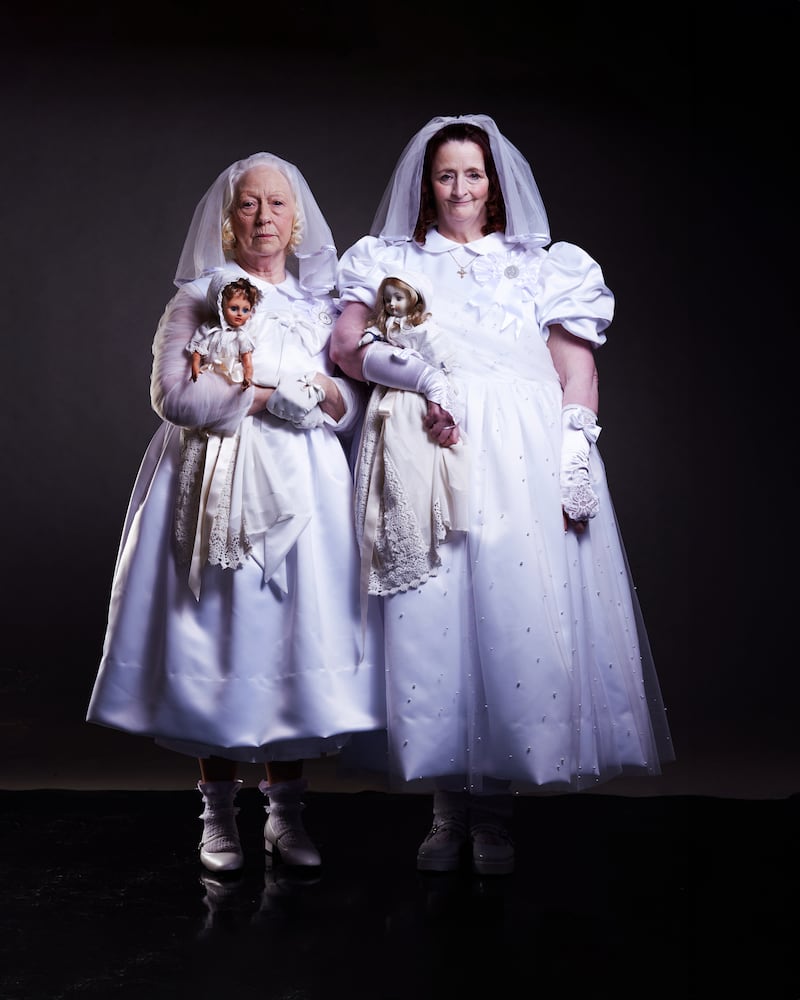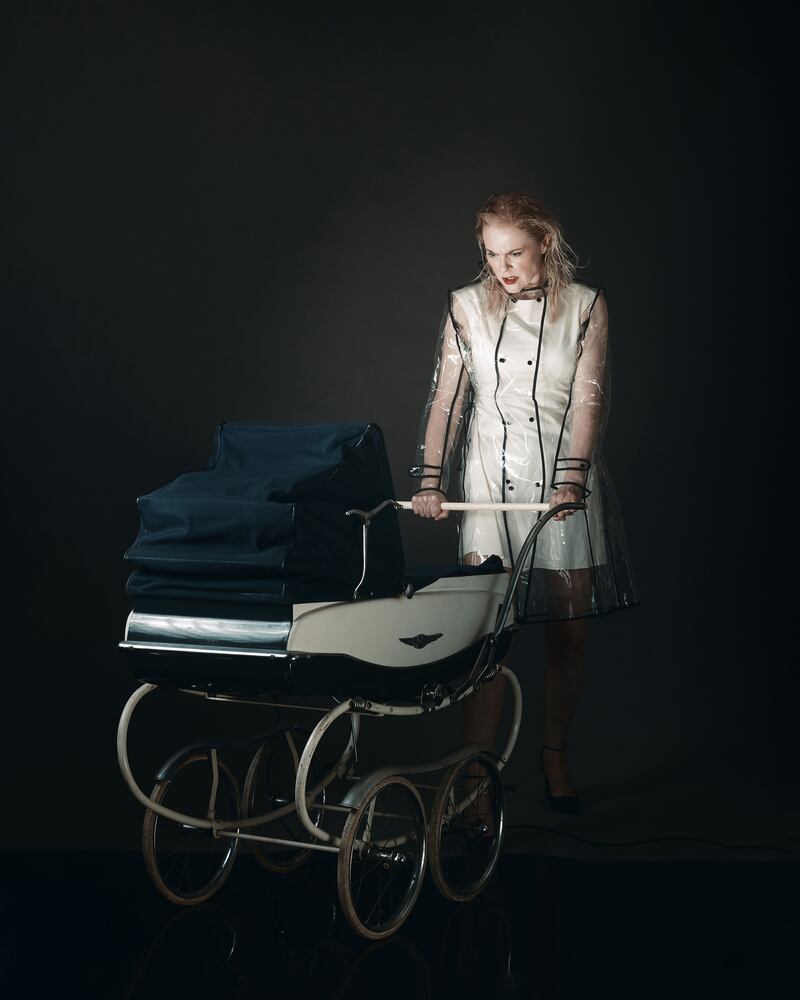I have been to the Abbey Theatre many times, but always as a member of the audience. Today I am going behind the scenes to glean a little about the elements involved in creating a show before it’s ready for the audience to see.
It’s week four of rehearsals for Marina Carr’s new play, Audrey or Sorrow, a coproduction between the Abbey and Landmark Productions. I am being brought through the bar and then up and down stairs, along corridors and through more doors, then up and down more stairs. It is like being in an Escher print. Hang on, is that a Louis le Brocquy? It is. The walls beyond the Abbey’s public areas have many wonderful paintings.
Eimer Murphy, who has the magnificent title of prop master, is bringing me to the props workshop. En route we go through the green room, which actors use when they’re offstage. It is actually painted a lime green, and looks a lot like a livingroom from a shared house. It has three big leather sofas, a glass coffee table, a breakfast counter, a left-over Christmas tree and a bookshelf with lots of paperbacks. I note that the Abbey actors have a particular fondness for the crime and thriller genre.
The props workshop has benches with saws and drills, plus two large fridges. Murphy has been explaining how she works out what props – which is to say any portable property, other than costumes – to make or source for a new play. “The first thing I do is read the script. I try and read it as someone telling me a story, but I also take notes, because I am looking for objects. Are the objects things that are seen or just talked about? There are three if not four fridges mentioned in the script, but we are only using one, otherwise it would be The Fridge Show.”
READ MORE
The fridges in the props room were bought on an online marketplace. One of them – the one that still has a door and a lot of quite bad smells within – is the one that is going to be starring on stage. The only reason it’s still here and not in the rehearsal room, where all the other props are, is that it needs to be altered first. “After the gas has been taken out we’ll take the back off, so we’ll be turning what looks like a fridge into a door.”
There are adult actors playing five- to seven-year-olds. I wanted to create something that looked sweet but creepy
— Katie Davenport, costume designer
There are ghosts in this show, and also a lot of babies. “Babies keep dying,” Murphy says. “I call them souls.” Her eternal challenge as a prop master is when babies are in a script. “You can’t have real babies on stage throughout a show. There’s a reason that babies on stage always look fake or like dolls, because if you try to make them look real, they look even more fake. You can’t have the audience wondering if the baby is real or fake: they have to accept it’s fake. It’s like cigarettes. We use herbal ones now, and everyone who smells them knows they aren’t real.”
Then it’s back into the labyrinthine corridors of the Abbey. Suddenly I’m out on a roof, where a red Portakabin – one of several – is marked “Stage Management”. We have to whisper while crossing the roof, because also up here – once intended to be the location of the staff canteen – is the rehearsal room. We can see the actors through the glass.
We go through another door and along a corridor lined with rails of costumes, each section with the name of the actor the clothes are for, with rows of shoes and boots on a long window sill. The wall opposite has costume sketches for all eight characters.
In Costumes, it looks as if Katie Davenport, Audrey or Sorrow’s costume designer, is sitting in a haberdashery shop. There are boxes of buttons, boxes of patterns dated by decade, containers of thread organised by colour, bolts of fabric and a set of boxes with labels such as “Bra hardware”, “Fur hooks”, “Brace clips”, “Eyelets” and “Military belt hooks”.
Hanging from a rail are two arresting and creepy-looking white Communion dresses. They are creepy because they’re adult-sized.
“There are adult actors playing five- to seven-year-olds,” Davenport explains. “I wanted to create something that looked sweet but creepy. I also exaggerated the details.” The communion medals pinned to the dresses are the size of side plates.
The eight characters have 53 costumes in total, which is an unusually high number. She describes it as “operatic in scale”. The costumes have to help tell the story, which I have gleaned by now includes ghosts, dead babies, and adults playing children.
“We were talking about the colours that children bring into houses, bright colours, and it unlocked the ghosts for me,” Davenport says, pointing to her drawings of brightly coloured tulle dresses. Again, they have a look of being clothes for children but in adult sizes. They are acid green and blue. “We wanted to punctuate some scenes with colour and liveliness. The fabric is tulle and organza, so there is an element of the ghost in the transparency and how you can see through the fabric.”
It took Davenport three weeks to do the drawings for the costumes, after coming up with her ideas. Some costumes are bought new, some come from the Abbey’s vast collection, and some, such as these oversized Communion dresses and tulle frocks, have to be specially made for the show. Fittings have to be arranged for each actor, scheduled for a time when they are not required to be in a particular scene; the rehearsal room has an adjoining door to the costume room. The Abbey uses three dressmakers, one of whom works in house.
“Once opening night comes I am gone,” Davenport says. It’s then up to other people to maintain the costumes, whether washing them or “spritzing” them, to freshen them up. The cast have two dressers to assist with the changes most of them have to make after each scene.
It’s on to the roof again, then in through a different door. I feel as if I should have arrived with a pocketful of pebbles to drop, to find my way back out of the building: it is not just a maze of corridors but seemingly a collection of different structures, including the Portakabins. Earlier in the morning a shuttered door had opened and left me out on the street, whereupon I had to go back through the main foyer to access the next part of the architectural puzzle that is behind the scenes at the Abbey.
[ Marina Carr: ‘There’s a whole world of women’s work that isn’t being seen’Opens in new window ]
When there is a break in rehearsals, I slip inside quietly. Part of the cast are going through a scene that will come midway through the play. The play has 12 scenes, played in two acts.
The rehearsal room is large and bright, and the actors are wearing their own clothes. At the back are small curtained rooms that stand in for the wings. Marina Carr is sitting on one of the sofas at the back of the room. The production’s stage manager, Brendan Galvin, is at a table by himself to the side. Five people are sitting in a row, intently watching the scene: Audrey or Sorrow’s director, Caitríona McLaughlin; assistant director, John King; voice director, Andrea Ainsworth; lighting designer, Sinéad Wallace; and movement director, Sue Mythen.

The scene I’m watching features Aisling O’Sullivan (Audrey), Zara Devlin (Maria), Patrick Martins (David), Anna Healy (Mac) and Marie Mullen (Grass). Plus a fake baby. It’s a highly charged scene. I scribble down some lines of dialogue, all of them intriguing questions.
“Was I ever anyone’s favourite child?”
“If they’re ghosts, what are we?”
“You know what your mother did to me?”
Occasionally, an actor forgets a line. “Blank,” they say swiftly, and Galvin, who has the script in front of him, calls out the line. It is mesmerising to watch these nascent performances. What audiences get to see is the finished, polished production. Witnessing a fragment of the process of how it is all put together is a fascinating insight.
At one point an alarm on a phone goes off. It is not my phone. I have been in such fear that mine might go off, break everyone’s concentration and disgrace me that it is on silent in a room two doors away. Yet still I slap my pockets in panic to check it’s not my phone. Praise be, the culprit is another onlooker.
At the end of the scene McLaughlin comes out on to the floor with her notes. “I wonder if there room for rage in Maria,” she says. There is discussion about hate and rage, and different kinds of hate. It is all very intense: this is, I learn later, a crucial scene in the play.
When the actors break for lunch I talk to Carr and McLaughlin. Carr is not usually here at this point in production: she came in for the first week of rehearsals and now pops in intermittently.
I ask each woman to encapsulate Audrey or Sorrow in a sentence.
“I couldn’t even try,” Carr replies with a laugh. Then she thinks. “It’s about three generations.”
“Three generations but one spirit,” McLaughlin says.
“The idea of being alive or half-alive.”
At this stage of rehearsal, the process is like when you are tidying the house. We have everything pulled out of cupboards and all on the floor
— Caitríona McLaughlin, director
“The idea at the centre of the play is very, very complex, but the sense of humour is evident.”
As it’s a new piece of work, has Carr been making changes to the script since rehearsals started?
“I’ve made the odd cut here and there, but it’s hard to gauge until you see the first whole run-through,” she says.
“At this stage of rehearsal,” McLaughlin says, “the process is like when you are tidying the house. We have everything pulled out of cupboards and all on the floor. The question is, what do we throw out and what do we keep?”
Galvin has worked at the Abbey on and off since 1985. I ask him to describe what he does.
“The stage manager’s job, under the stewardship of the director, is to co-ordinate whatever information from the rehearsal room needs to be passed on. Lighting, costume, sound.”
[ The Abbey: Shadow of a controversy lingers at Ireland’s national theatreOpens in new window ]
Of course, Galvin does so much more than that. He is there with the script in rehearsal to prompt the actors if needed, but it’s not merely a matter of giving them lines. “If there is a problem with a prop, or if something happens in rehearsal that’s not in the script, I’ll make a note, and put it in the rehearsal report every evening, and send it to all the creative team.”
In her scene today, for example, Aisling O’Sullivan removed her shoes and socks. If I was following it correctly without the help of a set, this scene took place on a beach.

“That bit, her taking off her shoes and socks, it’s not written into the script. But it might stay in. I’ll have to confer with Costume.” What Galvin means is that O’Sullivan’s removal of her shoes and socks will affect her costume for the rest of the scene.
A blackboard on one wall of the rehearsal room displays, among other things, a timeline of events in the play, costume drawings, photographs of houses like those the characters are meant to occupy, and a grid that shows the costumes each character wears in each scene. To look at the board is to have some understanding of how much work goes into each production, and how many diverse parts are involved: it’s like looking at charts in a war room.
I go back and retrieve my coat and my phone. It is, thankfully, still on silent.
Audrey or Sorrow is at the Abbey Theatre, Dublin, from Wednesday, February 28th, until Saturday, March 23rd, with previews from Friday, February 23rd














